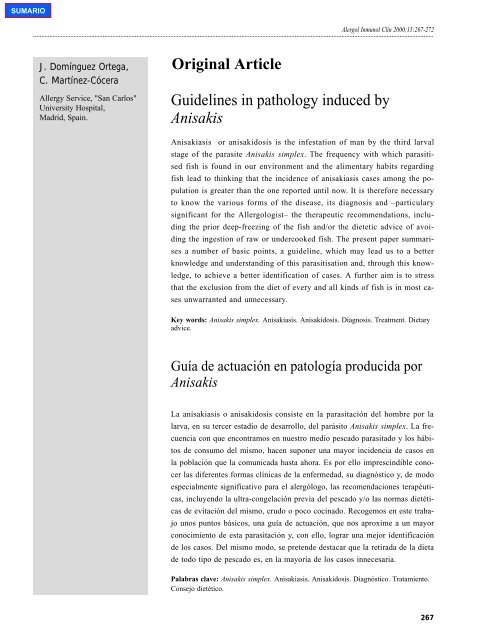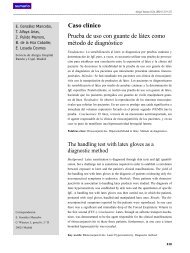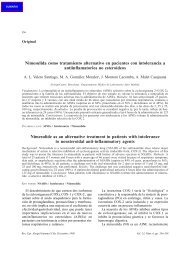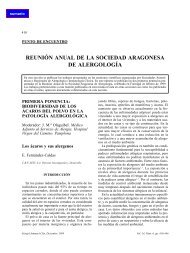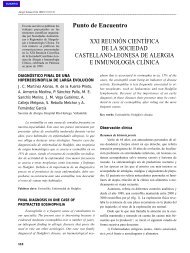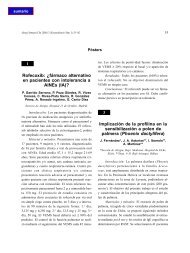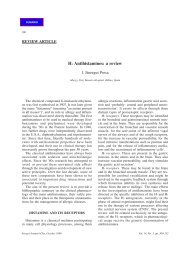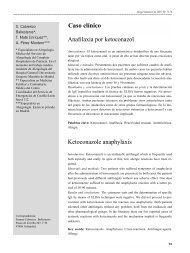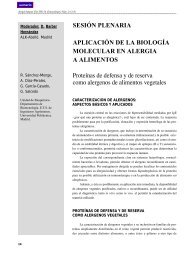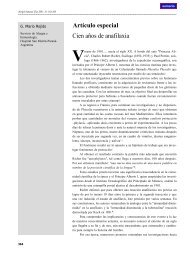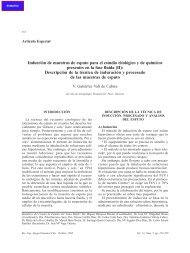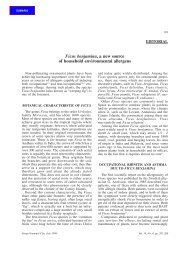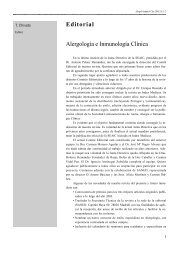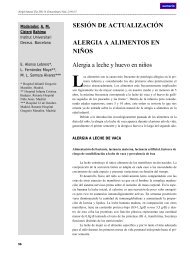Guidelines in pathology induced by Anisakis Original Article
Guidelines in pathology induced by Anisakis Original Article
Guidelines in pathology induced by Anisakis Original Article
You also want an ePaper? Increase the reach of your titles
YUMPU automatically turns print PDFs into web optimized ePapers that Google loves.
J. Domínguez Ortega,<br />
C. Martínez-Cócera<br />
Allergy Service, "San Carlos"<br />
University Hospital,<br />
Madrid, Spa<strong>in</strong>.<br />
Orig<strong>in</strong>al <strong>Article</strong><br />
Alergol Inmunol Cl<strong>in</strong> 2000;15:267-272<br />
<strong>Guidel<strong>in</strong>es</strong> <strong>in</strong> <strong>pathology</strong> <strong>in</strong>duced <strong>by</strong><br />
<strong>Anisakis</strong><br />
Anisakiasis or anisakidosis is the <strong>in</strong>festation of man <strong>by</strong> the third larval<br />
stage of the parasite <strong>Anisakis</strong> simplex. The frequency with which parasitised<br />
fish is found <strong>in</strong> our environment and the alimentary habits regard<strong>in</strong>g<br />
fish lead to th<strong>in</strong>k<strong>in</strong>g that the <strong>in</strong>cidence of anisakiasis cases among the population<br />
is greater than the one reported until now. It is therefore necessary<br />
to know the various forms of the disease, its diagnosis and –particulary<br />
significant for the Allergologist– the therapeutic recommendations, <strong>in</strong>clud<strong>in</strong>g<br />
the prior deep-freez<strong>in</strong>g of the fish and/or the dietetic advice of avoid<strong>in</strong>g<br />
the <strong>in</strong>gestion of raw or undercooked fish. The present paper summarises<br />
a number of basic po<strong>in</strong>ts, a guidel<strong>in</strong>e, which may lead us to a better<br />
knowledge and understand<strong>in</strong>g of this parasitisation and, through this knowledge,<br />
to achieve a better identification of cases. A further aim is to stress<br />
that the exclusion from the diet of every and all k<strong>in</strong>ds of fish is <strong>in</strong> most cases<br />
unwarranted and unnecessary.<br />
Key words: <strong>Anisakis</strong> simplex. Anisakiasis. Anisakidosis. Diagnosis. Treatment. Dietary<br />
advice.<br />
Guía de actuación en patología producida por<br />
<strong>Anisakis</strong><br />
La anisakiasis o anisakidosis consiste en la parasitación del hombre por la<br />
larva, en su tercer estadio de desarrollo, del parásito <strong>Anisakis</strong> simplex. La frecuencia<br />
con que encontramos en nuestro medio pescado parasitado y los hábitos<br />
de consumo del mismo, hacen suponer una mayor <strong>in</strong>cidencia de casos en<br />
la población que la comunicada hasta ahora. Es por ello impresc<strong>in</strong>dible conocer<br />
las diferentes formas clínicas de la enfermedad, su diagnóstico y, de modo<br />
especialmente significativo para el alergólogo, las recomendaciones terapéuticas,<br />
<strong>in</strong>cluyendo la ultra-congelación previa del pescado y/o las normas dietéticas<br />
de evitación del mismo, crudo o poco coc<strong>in</strong>ado. Recogemos en este trabajo<br />
unos puntos básicos, una guía de actuación, que nos aproxime a un mayor<br />
conocimiento de esta parasitación y, con ello, lograr una mejor identificación<br />
de los casos. Del mismo modo, se pretende destacar que la retirada de la dieta<br />
de todo tipo de pescado es, en la mayoría de los casos <strong>in</strong>necesaria.<br />
Palabras clave: <strong>Anisakis</strong> simplex. Anisakiasis. Anisakidosis. Diagnóstico. Tratamiento.<br />
Consejo dietético.<br />
267
J. Domínguez Ortega, et al<br />
INTRODUCTION<br />
Anisakiasis -or anisakidosis- represents the <strong>in</strong>festation<br />
of man <strong>by</strong> the third larval development stage of the<br />
parasite <strong>Anisakis</strong> simplex.<br />
The high rate of fish consumption <strong>in</strong> Spa<strong>in</strong> and the<br />
rather high frequency of its consumption as raw or undercooked<br />
preparations leads us to presume that the <strong>in</strong>cidence<br />
of disease conditions associated to contact with the <strong>Anisakis</strong><br />
simplex parasite is greater than the one reported up to<br />
now. A better knowledge of the cl<strong>in</strong>ical forms of these<br />
conditions on the side of the physician, and particularly so<br />
on the side of the Allergologist, is a s<strong>in</strong>e qua non requisite<br />
for their correct diagnosis. The present concise guidel<strong>in</strong>es<br />
aim at serv<strong>in</strong>g as a basis for a better approach to these diseases.<br />
The follow<strong>in</strong>g general outl<strong>in</strong>e may be considered at<br />
the time of approach<strong>in</strong>g the diagnosis of the disease and<br />
the ensu<strong>in</strong>g therapeutic <strong>in</strong>tervention:<br />
1. Anamnesis<br />
2. Initial complementary studies<br />
a) Pla<strong>in</strong> radiographies<br />
b) Ultrasonography<br />
c) Endoscopic procedures<br />
3. Anatomopathological study<br />
4. Immunoallergic study<br />
a) Sk<strong>in</strong> prick tests<br />
b) Quantitation of the serum total IgE and specific<br />
<strong>Anisakis</strong> simplex IgE levels<br />
c) IgE immunoblot<br />
d) Challenge tests<br />
ANAMNESIS<br />
A correct anamnesis is <strong>in</strong>dispensable for a correct<br />
diagnosis of the disease. A history of <strong>in</strong>gestion of raw or<br />
undercooked cephalopods or fish (salted, smoked, mar<strong>in</strong>ated,<br />
or <strong>in</strong>sufficiently cooked <strong>in</strong> a microwave oven 1 ) up to<br />
48-72 hours before the onset of symptoms is highly orientative.<br />
Although a large number of potentially <strong>in</strong>fested<br />
species exist, as demonstrated <strong>by</strong> Sanmartín et al. <strong>in</strong> 18 of<br />
23 species of fish from the Galician coast studied 2 , anchovies,<br />
which are frequently consumed raw (mar<strong>in</strong>ated <strong>in</strong> v<strong>in</strong>egar),<br />
and squid among the cephalopods, are frequently<br />
implicated. However, <strong>in</strong> each geographic area a seasonal<br />
cycle appears to exist <strong>in</strong> which the <strong>in</strong>festation of fish is<br />
more frequent.<br />
268<br />
1600<br />
1400<br />
1200<br />
1000<br />
800<br />
600<br />
400<br />
200<br />
0<br />
IgE IgE esp<br />
Specific IgE<br />
1 mes moth<br />
3 meses moth<br />
6 meses moth<br />
Fig. 1. Evolution of the serum total and specific anti-<strong>Anisakis</strong> simplex<br />
IgE. The graph reproduces the variations <strong>in</strong> the total and specific <strong>Anisakis</strong><br />
simplex IgE levels (mean values from a series of 12 patients<br />
with <strong>in</strong>test<strong>in</strong>al anisakiasis assessed at our Service) after one, three<br />
and six months of a strict fish-free diet.<br />
A good organ, system and apparatus anamnesis<br />
should be recorded, as there are several different cl<strong>in</strong>ical<br />
pictures that may be encountered. Among the gastro<strong>in</strong>test<strong>in</strong>al<br />
forms, the follow<strong>in</strong>g ones should be borne <strong>in</strong> m<strong>in</strong>d:<br />
The lum<strong>in</strong>al form is the one <strong>in</strong> which there is only<br />
adherence of the parasite to the digestive mucosa; this<br />
form is asymptomatic, and the larvae may be detected <strong>in</strong><br />
the faeces or the vomit.<br />
The gastric form features epigastric pa<strong>in</strong>, nausea and<br />
occasionally vomit<strong>in</strong>g. Cutaneous symptoms may also occur<br />
<strong>in</strong> association to the gastric manifestations 3 . The symptoms<br />
usually beg<strong>in</strong> 24 to 48 hours after the <strong>in</strong>gestion.<br />
The <strong>in</strong>test<strong>in</strong>al form mimics acute appendicitis, diverticulitis<br />
or ileitis. This form features abdom<strong>in</strong>al pa<strong>in</strong> and<br />
changes <strong>in</strong> the <strong>in</strong>test<strong>in</strong>al rhythm resembl<strong>in</strong>g an obstructive<br />
episode 4-6 (due to the fact that <strong>in</strong> the affected area the <strong>in</strong>test<strong>in</strong>al<br />
wall is covered <strong>by</strong> a fibr<strong>in</strong>ous exsudate and thickened<br />
<strong>by</strong> oedema). The ability to produce a number of proteases<br />
(am<strong>in</strong>opeptidase, tryps<strong>in</strong>e-like protease and several<br />
hyaluronidases) that may attack and degrade macromolecules<br />
and thus favour penetration enables the parasite larva<br />
to perforate the gastro<strong>in</strong>test<strong>in</strong>al mucosa. It is thus even<br />
possible to f<strong>in</strong>d true <strong>in</strong>test<strong>in</strong>al wall perforation lead<strong>in</strong>g to<br />
peritoneal manifestations 7 . Extra<strong>in</strong>test<strong>in</strong>al forms (hepatic,<br />
splenic and pulmonary) have been reported as well as totally<br />
extradigestive ones (articular <strong>in</strong>volvement, one case<br />
of asthma 8 and one of occupational conjunctivitis due to<br />
<strong>Anisakis</strong> sensitisation <strong>in</strong> a fishmonger 9 ).<br />
There is a group of patients who report cutaneous<br />
and systemic reactions after the <strong>in</strong>gestion of fish but tolerate<br />
such <strong>in</strong>gestion at other times. These patients have been<br />
<strong>in</strong>cluded <strong>in</strong> the condition traditionally termed "<strong>Anisakis</strong><br />
allergy". Although the most frequent manifestation is urticaria,<br />
angioedema and even anaphylactic shock have also
Fig. 2. Pla<strong>in</strong> film of the abdomen <strong>in</strong> bipedestation. Air-fluid levels and<br />
dilated <strong>in</strong>test<strong>in</strong>al loops can be seen.<br />
been reported. In some cases, the cutaneous or anaphylactic<br />
symptoms are associated to the digestive ones 10 .<br />
LABORATORY DETERMINATIONS<br />
As <strong>in</strong> many other disease conditions cours<strong>in</strong>g with an<br />
acute abdomen, the white blood cell differential count, although<br />
it may on occasion show no changes, may evidence<br />
a more or less marked leukocytosis with slight or moderate<br />
neutrophilia or eos<strong>in</strong>ophilia; a later <strong>in</strong>crease of the eos<strong>in</strong>ophil<br />
count may be observed start<strong>in</strong>g 24 hours after the onset<br />
of the cl<strong>in</strong>ical symptoms. The blood biochemistry is<br />
usually unremarkable unless complications of the <strong>in</strong>test<strong>in</strong>al<br />
pseudo-obstruction itself occur (repeated vomit<strong>in</strong>g, etc.).<br />
Although at present not rout<strong>in</strong>ely measured, the serum Eos<strong>in</strong>ophil<br />
Cationic Prote<strong>in</strong> (ECP) levels seem to be consistently<br />
and markedly <strong>in</strong>creased <strong>in</strong> this first phase, <strong>in</strong>dicat<strong>in</strong>g<br />
<strong>Guidel<strong>in</strong>es</strong> for <strong>Anisakis</strong>-<strong>in</strong>duced disease<br />
a marked eos<strong>in</strong>ophil activation and orient<strong>in</strong>g the diagnostic<br />
process towards an eos<strong>in</strong>ophilic <strong>in</strong>flammatory <strong>in</strong>filtrate.<br />
RADIOLOGY<br />
The gastric forms evidence no recognised radiological<br />
pattern. In the <strong>in</strong>test<strong>in</strong>al forms, the conventional radiology<br />
(pla<strong>in</strong> films of the abdomen) shows a pseudo-obstruction pattern,<br />
with dilated small <strong>in</strong>test<strong>in</strong>al loops and air-fluid levels <strong>in</strong><br />
the lateral decubitus or bipedestation projections (Fig. 2).<br />
The use of contrast media for imag<strong>in</strong>g does not represent<br />
a first choice, although images of wall thicken<strong>in</strong>g,<br />
<strong>in</strong>test<strong>in</strong>al lumen narrow<strong>in</strong>g with pseudotumour images,<br />
"f<strong>in</strong>gerpr<strong>in</strong>t" signs and, very rarely, radiolucent l<strong>in</strong>eal areas<br />
correspond<strong>in</strong>g to the larvae may be seen.<br />
In the ultrasonography, which is the imag<strong>in</strong>g technique<br />
of first choice <strong>in</strong> these cases, there is thicken<strong>in</strong>g of the <strong>in</strong>test<strong>in</strong>al<br />
wall, free peritoneal fluid <strong>in</strong> variable quantities, narrow<strong>in</strong>g<br />
of the <strong>in</strong>test<strong>in</strong>al lumen and dim<strong>in</strong>ished peristaltism 11 .<br />
ENDOSCOPY AND<br />
ANATOMOPATHOLOGICAL STUDIES<br />
The certa<strong>in</strong>ty diagnosis is provided <strong>by</strong> the visualisation<br />
of the larva or larvae at gastroendoscopy or colonoscopy;<br />
these procedures also allow the larvae to be removed and resolution<br />
of the cl<strong>in</strong>ical condition ensues. Moderate to severe<br />
mucosal oedema may be observed <strong>in</strong> the first two days after<br />
<strong>in</strong>festation <strong>by</strong> the parasite, the severity of the cl<strong>in</strong>ical symptoms<br />
and the endoscopic f<strong>in</strong>d<strong>in</strong>gs bear<strong>in</strong>g a close relationship<br />
to the duration of the condition 12 .<br />
The anatomopathological study of a surgical specimen<br />
will also allow the identification of <strong>Anisakis</strong> larvae. In the<br />
early stage of the parasitic <strong>in</strong>festation there is oedema and<br />
non-specific <strong>in</strong>flammatory <strong>in</strong>filtration; later stages <strong>in</strong>variably<br />
evidence an eos<strong>in</strong>ophilic <strong>in</strong>filtrate that may <strong>in</strong>volve only the<br />
mucosa, or also deeper layers of the <strong>in</strong>test<strong>in</strong>al wall (Figs. 4<br />
and 5). Peritoneal <strong>in</strong>volvement may be seen after perforation<br />
of the <strong>in</strong>test<strong>in</strong>al wall <strong>by</strong> the parasite has occurred.<br />
SKIN TESTS AND IGE DETERMINATIONS<br />
Sk<strong>in</strong> prick tests<br />
The sk<strong>in</strong> prick tests are usually performed with com-<br />
269
J. Domínguez Ortega, et al<br />
Fig. 3. Abdom<strong>in</strong>al ultrasonography show<strong>in</strong>g thickened walls of the<br />
<strong>in</strong>test<strong>in</strong>al loops and free <strong>in</strong>traabdom<strong>in</strong>al fluid.<br />
mercial <strong>Anisakis</strong> simplex extracts at a 1-mg/ml concentration,<br />
with both early (15 m<strong>in</strong>) and late (24 h) read<strong>in</strong>gs. A<br />
number of cases of anaphylaxis dur<strong>in</strong>g sk<strong>in</strong> prick test<strong>in</strong>g<br />
have been reported 13 .<br />
The sk<strong>in</strong> prick tests have low specificity, as they do<br />
not discrim<strong>in</strong>ate between true positive results and cross-reactions<br />
to other parasites such as Ascaris or Ech<strong>in</strong>ococcus.<br />
The sk<strong>in</strong> tests with a panel of different fish extracts<br />
are consistently negative.<br />
IgE quantitation<br />
The serum levels of total IgE and <strong>Anisakis</strong> simplexspecific<br />
IgE are assessed us<strong>in</strong>g the CAP-radioimmunoassay<br />
technique. Increased levels of both are usually found<br />
and their evolution has been observed to be associated, the<br />
total and specific IgE levels decreas<strong>in</strong>g together over time<br />
if a fish- and cephalopod-free diet is <strong>in</strong>stituted 14 (Fig. 1).<br />
IgE, IgG and IgA immunoblot<br />
These techniques are useful for the differentiation of<br />
cross-reactions from true anisakiasis. Although no homogeneous<br />
pattern is known to exist, <strong>in</strong> the first case (cross reactions)<br />
the sera recognise exclusively <strong>in</strong>termediate-molecular weight<br />
antigens when tested aga<strong>in</strong>st the parasite prote<strong>in</strong>s, while the<br />
sera of patients with true <strong>Anisakis</strong> <strong>in</strong>festation will also recognise<br />
low-molecular weight (14 - 30 kDa) antigens15 (Fig. 6).<br />
These low molecular weight antigens are thought to correspond<br />
to so-called secretory/excretory larval antigens<br />
DIETETIC CONSIDERATIONS<br />
When faced with a patient diagnosed of anisakiasis,<br />
the question arises whether a strict fish-free diet is absolu-<br />
270<br />
Figs. 4 and 5. Histo<strong>pathology</strong> study of the surgical specimen of a<br />
patient with suspected anisakiasis. There is a marked eos<strong>in</strong>ophyllic<br />
<strong>in</strong>filtrate extend<strong>in</strong>g even <strong>in</strong>to the muscular layer of the <strong>in</strong>test<strong>in</strong>al wall.<br />
tely necessary, and even more so when fish represents a<br />
basic alimentary component <strong>in</strong> many other conditions such<br />
Fig. 6. IgE immunoblot (from the studies <strong>by</strong> Dr. Moneo and Dr. Fernández<br />
de Corres). Several <strong>in</strong>termediate-molecular weight bands<br />
(30 - 50 kDa) as well as other low-molecular weight ones (14 - 30<br />
kDa) can be identified.
as coronary artery disease or <strong>in</strong> the treatment of morbid<br />
obesity.<br />
Some authors consider that repeated, sometimes<br />
asymptomatic <strong>in</strong>festation may trigger a sensitisation to<br />
prote<strong>in</strong> antigens, <strong>in</strong>duc<strong>in</strong>g an IgE-mediated response and<br />
thus the cutaneous or anaphylactic manifestations. These<br />
authors recommend full avoidance of any fish or seafood<br />
whatsoever.<br />
However, an ever-<strong>in</strong>creas<strong>in</strong>g group of <strong>in</strong>vestigators<br />
postulates that this condition actually represents an unusually<br />
<strong>in</strong>adequate response to the parasite, similar to that<br />
seen <strong>in</strong> other parasitoses such as ech<strong>in</strong>ococcosis (hydatid<br />
cyst disease). The presence of the live parasite <strong>in</strong> the gastro<strong>in</strong>test<strong>in</strong>al<br />
mucosa would then <strong>in</strong>duce the release of secretory/excretory<br />
antigens and an IgE-mediated response<br />
to the parasitic <strong>in</strong>festation. In this context, a number of<br />
groups <strong>in</strong> our own country are currently perform<strong>in</strong>g oral<br />
challenge tests with lyophilised or frozen larvae both <strong>in</strong><br />
patients with "gastroallergic" anisakiasis 16 and <strong>in</strong> those<br />
with only cutaneous and/or anaphylactic symptoms, and<br />
their results lend support to the second theory.<br />
MANAGEMENT<br />
The management of the gastro<strong>in</strong>test<strong>in</strong>al forms of<br />
<strong>Anisakis</strong>-<strong>in</strong>duced disease should be conservative if extraction<br />
of the larvae is not achieved, although even surgery<br />
may become necessary <strong>in</strong> cases with <strong>in</strong>test<strong>in</strong>al perforation<br />
and peritonitis.<br />
In the cutaneous and/or anaphylactic forms, the management<br />
should consist of immediate medical <strong>in</strong>tervention<br />
with adm<strong>in</strong>istration of ep<strong>in</strong>ephr<strong>in</strong>e, antihistam<strong>in</strong>es and<br />
parenteral corticosteroids <strong>in</strong> the same way as for any secondary<br />
anaphylactic reaction of any aetiology.<br />
However, it should be po<strong>in</strong>ted out that the fundamental<br />
basis of the management of this particular parasitic<br />
<strong>in</strong>festation is that of prophylactic measures so as to prevent<br />
the <strong>in</strong>gestion of the live parasite:<br />
Avoidance of the <strong>in</strong>gestion of raw or poorly cooked<br />
fish <strong>in</strong>clud<strong>in</strong>g salted, smoked, soused or mar<strong>in</strong>ated fish or<br />
<strong>in</strong>sufficiently-cooked fish preparations (microwave oven<br />
or grill).<br />
Deep-freez<strong>in</strong>g the fish at -20ºC for at least 72 hours<br />
prior to its preparation for consumption. Fish that has been<br />
deep-frozen already <strong>in</strong> the fish<strong>in</strong>g grounds should be preferred,<br />
as this has been eviscerated at an early stage and<br />
the possibility of parasites hav<strong>in</strong>g passed <strong>in</strong>to the flesh is<br />
<strong>Guidel<strong>in</strong>es</strong> for <strong>Anisakis</strong>-<strong>in</strong>duced disease<br />
consequently less. Any cook<strong>in</strong>g of fish or cephalopods<br />
should atta<strong>in</strong> core temperatures of at least 60ºC.<br />
Insist<strong>in</strong>g on adequate legislation as to production and<br />
market<strong>in</strong>g of fishery products, with strict health and sanitary<br />
controls <strong>by</strong> the authorities concerned to guarantee<br />
compliance. Such legislation has already been implemented<br />
<strong>in</strong> the Netherlands, achiev<strong>in</strong>g a marked reduction <strong>in</strong><br />
the number of cases. Similar legislation exists also <strong>in</strong><br />
Spa<strong>in</strong>, although the high rate of home-preparation of fish<br />
may perhaps h<strong>in</strong>der its correct application.<br />
REFERENCES<br />
1. Cnut Blasco A, Labora Lóriz A, López de Torre J, Romeo Martínez<br />
JA. Anisakiasis gástrica aguda por cocción <strong>in</strong>suficiente en horno microondas.<br />
Med Cl<strong>in</strong> 1996; 106: 317-318.<br />
2. Sanmartín ML, Qu<strong>in</strong>tero P, Iglesias R, Santamaría MT, Leiro J,<br />
Ubeira FM. Nemátodos parásitos en peces de las costas gallegas.<br />
Madrid. Díaz de Santos, 1994; 31-37.<br />
3. Alonso A, Daschner A, Moreno-Ancillo A. Anaphylaxis with <strong>Anisakis</strong><br />
simplex <strong>in</strong> the gastric mucosa. N Engl J Med 1997; 337: 350-351.<br />
4. López Vélez R, García A, Barros C, Mazarbeitia F, Oñate JM. Anisakiasis<br />
en España. Descripción de 3 casos. Enf Infecc Microbiol<br />
Cl<strong>in</strong> 1992; 10: 158-161.<br />
5. Martín Cabanna J, Monturiol JM, Louredo A, Valentín Gamazo C,<br />
Jiménez J, Jiménez P, Alcázar JA, Rueda JA, Quitans A. Abdomen<br />
agudo y anisakiasis: a propósito de dos casos. Cir Esp 1994; 56<br />
Supl 1: 265.<br />
6. Gómez B, Tabar AI, Larr<strong>in</strong>aga B, Álvarez MJ, García BE, Olaguibel<br />
JM. Eos<strong>in</strong>ophilic gastroenteritis and <strong>Anisakis</strong>. Allergy 1998; 53:<br />
1148-1154.<br />
7. Arenal Vera JJ, Marcos Rodríguez JL, Borrego P<strong>in</strong>tado MH, Castro<br />
L, Blanco Álvarez JL. Anisakiasis como causa de apendicitis aguda y<br />
cuadro reumatológico: primer caso en la literatura médica. Rev Esp<br />
Enf Digest 1991; 79: 355-358.<br />
8. Armentia A, Lombardero M, Callejo A, Martín Santos JM, Gil FJ,<br />
Vega J, Arranz ML, Martínez C. Occupational asthma <strong>by</strong> <strong>Anisakis</strong><br />
simplex. J Allergy Cl<strong>in</strong> Immunol; 102: 831-4.<br />
9. Añíbarro B, Seoane FJ. Occupational conjuctivitis caused <strong>by</strong> sensitization<br />
to <strong>Anisakis</strong> simplex. J Allergy Cl<strong>in</strong> Immunol 1998; 102: 331-<br />
332.<br />
10. Moreno-Ancillo A, Caballero MT, Cabañas R, Contreras J, Martín<br />
Barroso JA, Barranco P, López Serrano MC. Allergic reactions to <strong>Anisakis</strong><br />
simplex parasit<strong>in</strong>g seafood. Ann Allegy Asthma Immunol 1997;<br />
79: 246-250.<br />
11. Shirama M, Koga T, Ishibashi H, Uchida S, Ohta Y, Shimoda Y.<br />
Intest<strong>in</strong>al anisakiasis: US <strong>in</strong> diagnosis. Radiology 1992; 185:789-<br />
793.<br />
12. Saburo Kakizoe, Hiroshi Kakizoe, Keiji Kakizoe, Yumiko Kakizoe,<br />
Masumi Maruta, Tamako Kakizoe, Sh<strong>in</strong>obu Kakizoe. Endoscopic<br />
f<strong>in</strong>d<strong>in</strong>gs and Cl<strong>in</strong>ical Manifestation of Gastric Anisakiasis. Am J Gastroenterol<br />
1995; 90: 761-763.<br />
13. Carretero P, Rivas C, Todo P, Gómez B, Núñez C, Alday E, More-<br />
271
J. Domínguez Ortega, et al<br />
no I. Anafilaxia tras realización de prick-test a <strong>Anisakis</strong> simplex. Rev<br />
Esp Alergol Inmunol Cl<strong>in</strong> 1998; 13: 226-228.<br />
14. Daschner A, Alonso Gómez A, Caballero T, Suárez de Parga JM,<br />
López Serrano MC. Usefulness of early serial measurement of specific<br />
and total immunoglobul<strong>in</strong> E <strong>in</strong> the diagnosis of gastroallergic anisakiasis.<br />
Cl<strong>in</strong> Exp Allergy 1999; 29: 1260-1264.<br />
272<br />
15. García M, Moneo I, Audícana MT, Del Pozo MD, Muñoz D, Fernández<br />
E, Díez J, Etxenagusia MA, Ansotegui IJ, Fernández de Corres<br />
L. The use of IgE immunoblott<strong>in</strong>g as a diagnostic tool <strong>in</strong> <strong>Anisakis</strong><br />
simplex allergy. J Allergy Cl<strong>in</strong> Immunol 1997; 99: 497-501<br />
16. Alonso A, Moreno-Ancillo A, Daschner A, López Serrano MC.<br />
Dietary assessment <strong>in</strong> five cases of allergic reactions due to gastroallergic<br />
anisakiasis. Allergy 1999; 54: 517-520.


